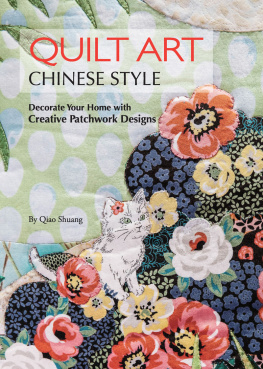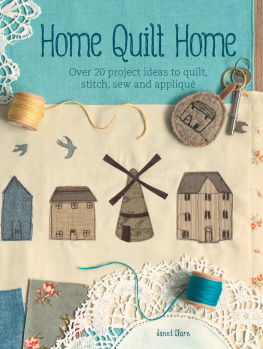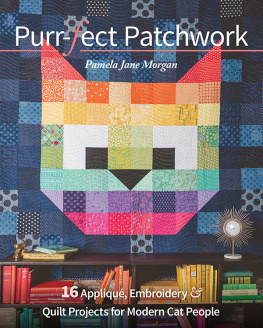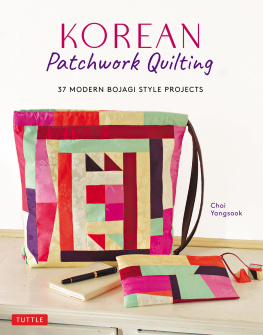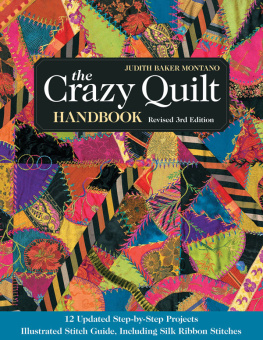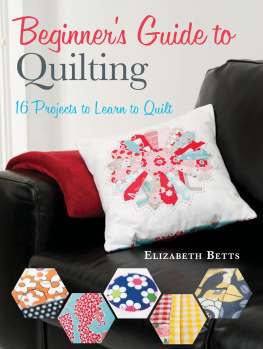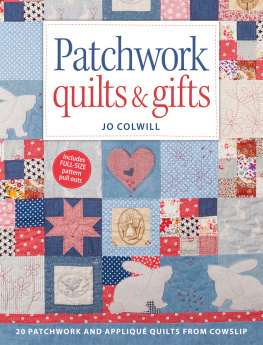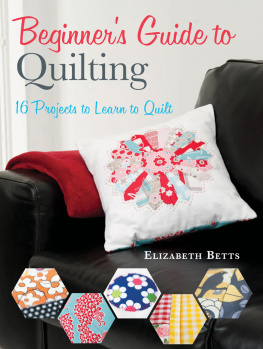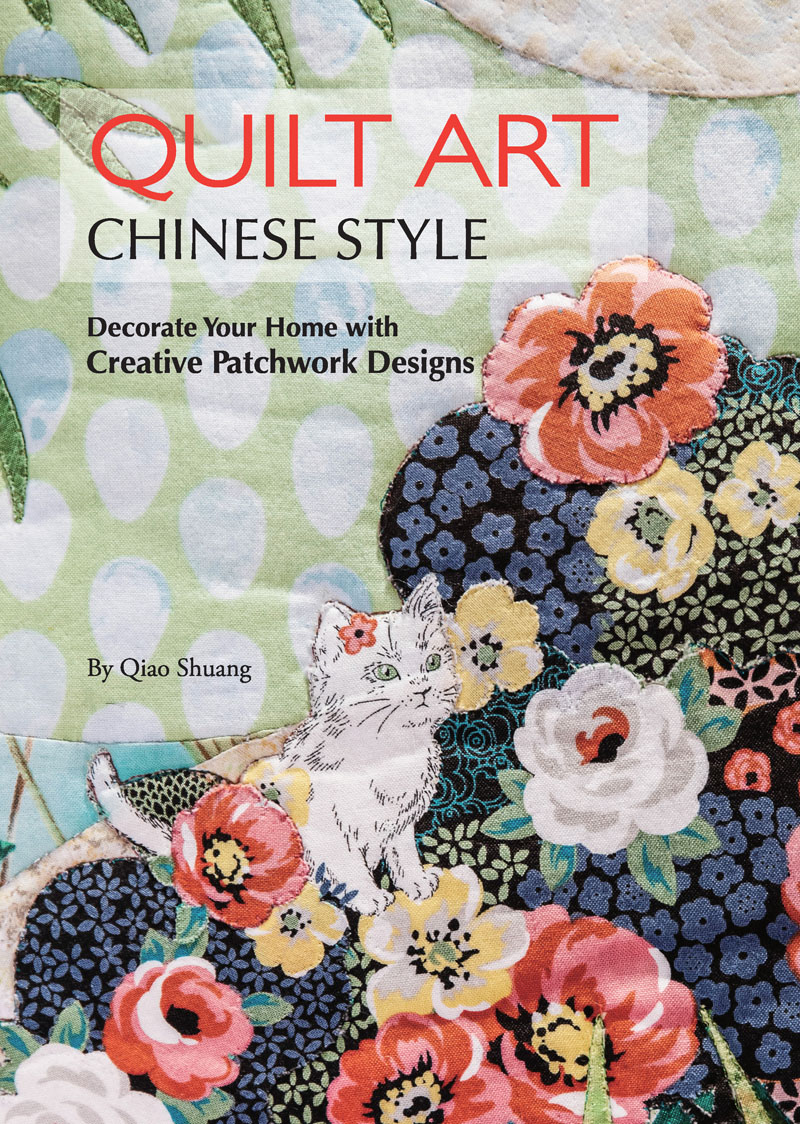

Fig. 1 Fabric from Moda Fabrics
I bought this blue and gray fabric years ago, and it reminds me of a typical Chinese watertown surrounded by farmlands, rivers, and lakes and shrouded in mistsan eternal theme in traditional Chinese painting.
Fig. 2Purity (detail)
Height 200 cm Width 200 cm
Artist: Zhou Liangyun
This large chenille project drew much of its inspiration from a modern architectural project. It is the result of four-month experimentation with various methods of stiching and cutting. The sharp contrasts between colors and the combination of geometric shapes give the project a sense of abstraction.
Copyright 2019 Shanghai Press and Publishing Development Co., Ltd.
All rights reserved. Unauthorized reproduction, in any manner, is prohibited.
This book is edited and designed by the Editorial Committee of Cultural China series.
Project Design and Text: Qiao Shuang
Photograph: Zhou Feiyu
Digital Drawing: Hong Jiaxin
Translation: Jiang Yajun
Cover Design: Wang Wei
Interior Design: Li Jing, Hu Bin (Yuan Yinchang Design Studio)
Copy Editor: Susie Gordon
Editorial Assistant: Pei Zhuomin
Editors: Wu Yuezhou, Cao Yue
Editorial Director: Zhang Yicong
Senior Consultants: Sun Yong, Wu Ying, Yang Xinci
Managing Director and Publisher: Wang Youbu
ISBN: 978-1-60220-040-1
Address any comments about Quilt Art: Chinese Style to:
Better Link Press
99 Park Ave
New York, NY 10016
USA
or
Shanghai Press and Publishing Development Co., Ltd.
F 7 Donghu Road, Shanghai, China (200031)
Email:
Printed in China by Shenzhen Donnelley
Printing Co., Ltd.
1 3 5 7 9 10 8 6 4 2

Fig. 3 The Three and All Series (detail)
Please refer to .
CONTENTS

Fig. 4 Different fabrics with blue flower patterns.

Fig. 5 Different fabrics cut in blocks.

Fig. 6Dunhuang Caissons (Tablecloth, detail)
Height 300 cm Width 200 cm
Artist: Qiao Shuang
The tablecloth features a caisson from the Dunhuang Grottoes in Chinas northwestern Gansu Provincean architectural feature typically found in the center of a richly decorated ceiling. The project feature flowers and geometric patterns highlighted against a dark blue background. The detail is one of the flower patterns.
Preface

Fig. 7 Appliqu Studio
The project features a wall in an appliqu studio, which is covered in samples of various colors, styles, and themes by appliqu lovers.
I t must have been a million-to-one chance that I was introduced to the craft of patchwork and fell in love with it. A year later, as a lecturer at Nanjing University of the Arts, I offered to teach it and work with my students on our own projects. While my experience with the craft over the past ten years is far from enough to make me a seasoned patchwork artist, it has benefited me enormously as a university lecturer, as I teach other courses in the textile design program. I am more than a little proud of the many projects that I and my students have completed.
This book showcases some of these projects. While step-by-step explanations are offered, I also focus on how the ideas were conceived, how the designs were created, and how improvements were made. In addition, as an owner of a patchwork and embroidery studio, I work with crafters from all over the country, some of whom hope to be freelance artists and some of whom simply wish to be more creative. For the past few years, I have helped many of them reach satisfaction with their projects. Some of cases are analyzed in this book, which I believe will be a source of inspiration for readers.

Fig. 8Four Seasons
Height 315 cm Width 165 cm 4 pieces
Artists: Chen Jinmin, Yuan Zhendong, and Gao Manman
This joint project shows what is seen in different seasons through a window in a traditional building in a Suzhou Guarden. The combinations of heavy, stifling colors are impressionistic, while the window edges are abstract and deconstructive, successfully integrating Western artistic features into traditional Chinese art forms.
CHAPTER
Patchwork: A Brief History
P atchwork is often defined as a form of needlework that involves sewing pieces of fabric together into a larger design. Sometimes, pieced quilts are also known as patchworks. In the latter case, the larger piece becomes the top of a three-layered quilt, with the middle as the batting and the bottom as the backing.

Fig. 9A Kingfisher
Height 30 cm Width 30 cm
Artist: Qiao Shuang
The project is the result of an extensive modification of an original design due to the bird in the background. The slanting bamboo branches and the bird form make up a typical composition in Chinese painting. The colors and the patterns of the fabric are always a source of inspiration.

Fig. 10 A Quilt
Height 150 cm Width 150 cm
Artist: Qiao Shuang
All the pieces in this project were created individually during my appliqu course learning, but together they form a great traditional geometric quilt cover.
It is virtually impossible to trace the origins of patchwork as a craft (), because natural fabric does not often stand the test of time. It is generally believed that the earliest example of patchwork is the wrapper around the body of an Egyptian Pharaoh, which is believed to date back as far as 5,000 years. The Mongolians are also believed to have been appliqu masters as early as 100 BCAD 200.
The surviving examples of patchwork robes used by Buddhist monks and priests in the Tang dynasty (618907) show that the Chinese employed advanced sewing techniques. Remains of pieced silk fabric from the 6th to the 9th century were also found in the cave where the Buddha Shakyamuni is believed to have lived. As the cave is located along the ancient Silk Road connecting China to Western Europe, archeologists generally agree that it must have come from China.

